Congratulations to this year’s award winners
The International Society for Landscape, Place, & Material Culture is pleased to announce the recipients of its 2023 Awards:
Henry H. Douglas Distinguished Service Award
From the award presentation:
The Award is named in honor of the founder of The Society, Mr. Henry H. Douglas, and is given to an individual who has made significant contributions over the years in furthering the Society’s goals through service, teaching, publications, and/or the promotion of historic preservation. This year’s recipient is Dr. Chris Post.
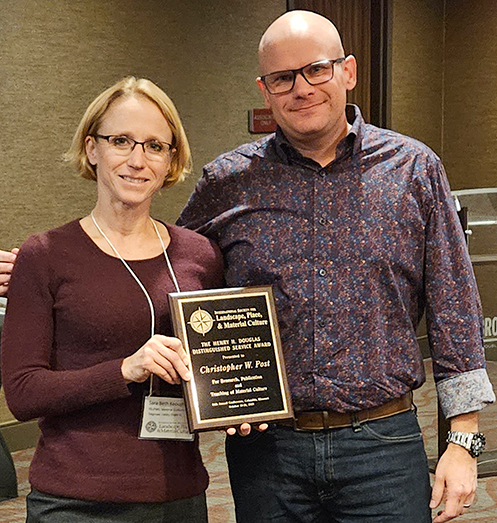
Chris is a cultural and historical geographer who focuses on the heritage of place, particularly through commemoration, place naming and sense of place. He holds Masters and PhD degrees in Geography from the University of Kansas and is Professor of Geography at Kent State University. His list of publications is extensive, including the co-edited volume The Routledge Companion to the American Landscape and chapters in several books such as Affective Architectures, Company Towns in the Americas, Social Memory and Heritage Tourism Methodologies, and Explorations in Place Attachment. His articles have appeared in the journals Acme, Geoforum, Area, Professional Geographer, Geographical Review, Journal of Cultural Geography, Journal of Geography, and Historical Geography.
Chris has been an active member of ISLPMC, serving the organization as the Book Review Editor of Material Culture from 2007-2013, chairing the Wilhelm-Keiffer Student Paper Award committee since 2011, organizing the annual conference in Canton, Ohio, in 2015, and has served several three-year terms on the board of directors. At Kent State, he leads interpretive field trips for his students and colleagues and currently serves as the May 4 Researcher in Residence. In this role, supported by a large grant from the National Endowment for the Humanities, Chris has been instrumental in the re-interpretation of the May 4 Memorial on the Kent State Campus. Those of us who were at the ISLPMC conference in Canton had the honor of touring the May 4 commemoration site with Chris himself.
In short, Chris has dedicated his career to the promotion of commemorative places and ISLPMC is a stronger organization because of his efforts.
W. Frank Ainsley Outstanding Service Award
No award given this year.
The Wilhelm-Keiffer Student Research Award
In honor of the contributions of both Dr. Hubert Wilhelm and his protégé, Dr. Artimus Keiffer, the Wilhelm-Keiffer Student Research Award provides current and recently graduated undergraduate students with the opportunity to compete for a research award in the field of material culture studies by completing and presenting a poster at the annual ISLPMC Meeting.
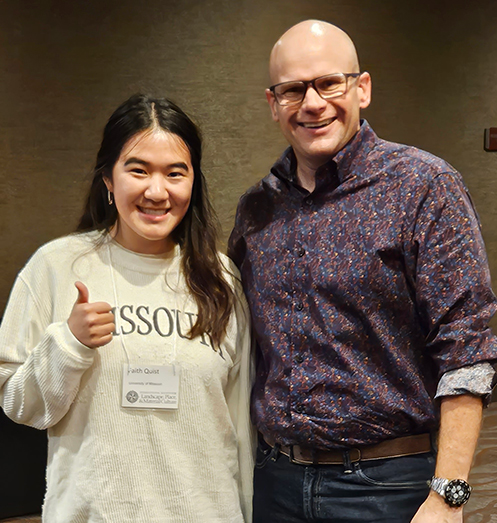
ISLPMC presented Faith Quist with the annual Wilhelm-Keiffer award at the 2023 Annual Meeting. Ms. Quist presented her recent titled, “North Korean Defection Patterns and Sense of Place.” In this work, she presented the global pattern of North Korean defectors and traced the opportunities each group has in forging a connection to their new homes outside of North Korea. What is more, she also explained the many challenges faced by North Koreans in producing a sense of place in other countries. For example, those in South Korea are usually resettled in various locations throughout the country as one way to prevent communication and organization out of a concern for uprising and violence. Ms. Quist received funding from the University of Missouri’s Honors College Peggy and Andrew Cherng Summer Scholars Program. Congrats to Faith on her work and award.
Fred B. Kniffen Book Award
Cory Jensen, chair of the Kniffen Award Committee presented the award. From the presentation:
First, I would like to thank my fellow members of the Book Awards Committee, Stephanie Roper and Jeff Wanser, for spending hours of time this summer reviewing all the book award submissions. I would also like to thank Ellen Hostetter for the time she spent in receiving and logging the submissions and especially in carrying heavy boxes to the post office to ship to us for review!
The International Society of Landscape, Place and Material Culture seeks to encourage and recognize books by authors regarding material culture in North America. Named for the renowned geographer, Fred Kniffen, the prize in his honor is granted annually for the best book in the field published within two years of the award.
Although the number of submissions we’ve received the past couple of years is about half of what we typically get (most likely thanks to Covid still), I felt that there was a higher percentage of quality books that met the award guidelines. I had several books in my Finalists list, but in the end, we as a committee all agreed on one.
So, with that, I am pleased to announce that the winner of the 2023 Fred B. Kniffen Award is: Paul Hardin Kapp's Heritage and Hoop Skirts: How Natchez Created the Old South, published by University Press of Mississippi.
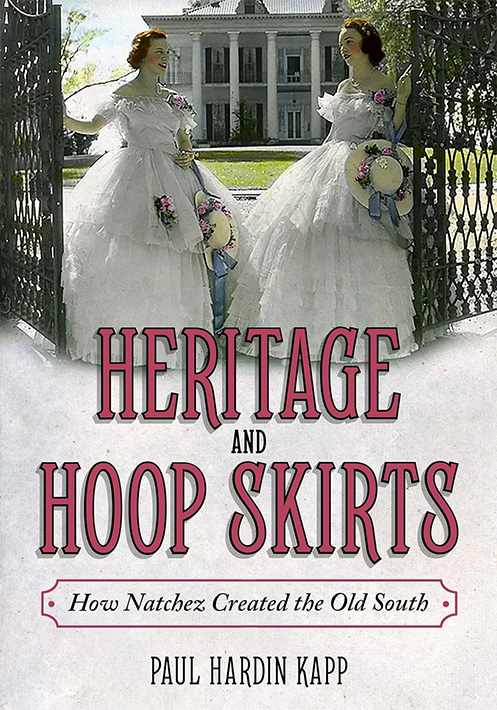
Paul Hardin Kapp has authored and co-edited a number of books and is Associate Professor of Architecture, teaching historic preservation. He is also the Associate Director of the Collaborative for Cultural Heritage Management at the University of Illinois at Urbana-Champaign, and he is a Recognized Lecturer at the Ironbridge International Institute for Cultural Heritage at the University of Birmingham (UK). His courses focus on historic preservation design, preservation theory, and the conservation of historic building materials.
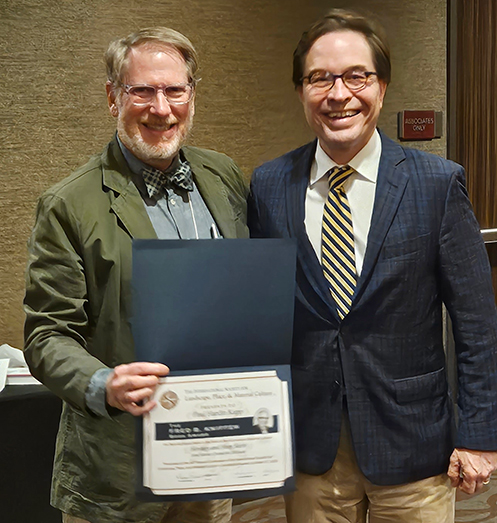
I want to read a short description from the book that explains it better than I could:
“For over eighty years, tourists have flocked to Natchez, Mississippi, seeking the ‘Old South,’ but what they encounter is invention: a pageant and rewrite of history first concocted during the Great Depression. In Heritage and Hoop Skirts, author Paul Hardin Kapp reveals how the women of the Natchez Garden Club saved their city, created one of the first cultural tourism economies in the United States, changed the Mississippi landscape through historic preservation, and fashioned elements of the Lost Cause into an industry.
“Beginning with the first Natchez Spring Pilgrimage of Antebellum Homes in 1932, [these women] challenged the notion that smokestack industries were key to Natchez’s prosperity. The[y] developed a narrative of graceful living and aristocratic gentlepeople centered on grand but decaying mansions. In crafting this pageantry, they created a tourism magnet based on the antebellum architecture of Natchez. Through their determination and political guile, they enlisted New Deal programs, such as the WPA Writers’ Project and the Historic American Buildings Survey, to promote their version of the city.
“Their work did save numerous historic buildings and employed both white and African American workers during the Depression. Still, the transformation of Natchez into a tourist draw came at a racial cost and further marginalized African American Natchezians. By attending to the history of preservation in Natchez, Kapp draws on a rich archive of images, architectural documents, and popular culture to explore how meaning is assigned to place and how meaning evolves over time. In showing how and why the Natchez buildings of the “Old South” were first preserved, commercialized, and transformed into a brand, this volume makes a much-needed contribution to ongoing debates over the meaning attached to cultural patrimony."
We felt that this book captured the spirit of the Kniffen award in its discussion of historic preservation that is impacted by the influence of a local brand of early heritage and cultural tourism that shaped an entire community and industry.
On behalf of the International Society of Landscape, Place and Material Culture, I would like to congratulate Mr. Kapp on receiving this award for a great written work!
ISLPMC Historic Preservation Award
From the award presentation:
The Friends of Arrow Rock formed in 1959, when local residents who cared deeply about the village’s collection of historic building joined together to preserve their heritage. More than six decades later, this organization is still committed to its ideals and still attracts members who are passionate about historic preservation.
Located in the state’s “Boone’s Lick” region, the village of Arrow Rock dates back to 1829, when it was formally platted and known as New Philadelphia. In 1833, the village became Arrow Rock, the name of a series of stone bluffs. From the time of antiquity, the Arrow Rock bluffs were a well-known landmark on the Missouri River. For thousands of years, the area’s Native Americans used stone from the bluffs to point their arrows. Visible for many miles, the bluffs first appeared on a 1732 map as “pierre á fleche,” which is French for “rock of arrows.” Soon after the Louisiana Purchase, the geological feature took on its Anglicized name.
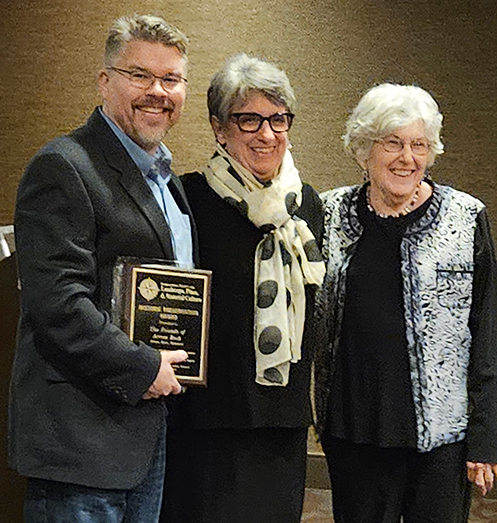
Arrow Rock was largely settled by southerners, who brought enslaved African-Americans with them. Following their emancipation, black residents soon built a church, which also served as the first black school. During the remainder of the 19th century, both the village and Missouri River traffic lost importance to railroads cutting through central Missouri. A major fire in 1901 destroyed a portion of the town’s commercial area. During the 20th century, Arrow Rock continued to lose population as automobile highways began to replace the railroads as transportation corridors. Today, only 50-some people are full-time residents of the village, but the streets fill with visitors who come to enjoy the hospitality of this charming bit of old Missouri.
A portion of the town is also preserved as Arrow Rock State Historic Site. The creation of the state historic site resulted from the efforts of first the National Old Trails Road Association and later the Daughters of the American Revolution to preserve a 19th-century tavern. Today, Missouri State Parks operates the historic site, which manages several historic buildings and a modern visitor center. The visitor center contains artifacts and exhibits that portray the history of the town and the Boone's Lick region.
Arrow Rock is an example of a highly successful public-private partnership, in that the friends group also owns a number of historic buildings and cooperates with Missouri State Parks to give guided tours of the village. In 1964, just five years after the organization began, the entire community received National Historic Landmark designation.
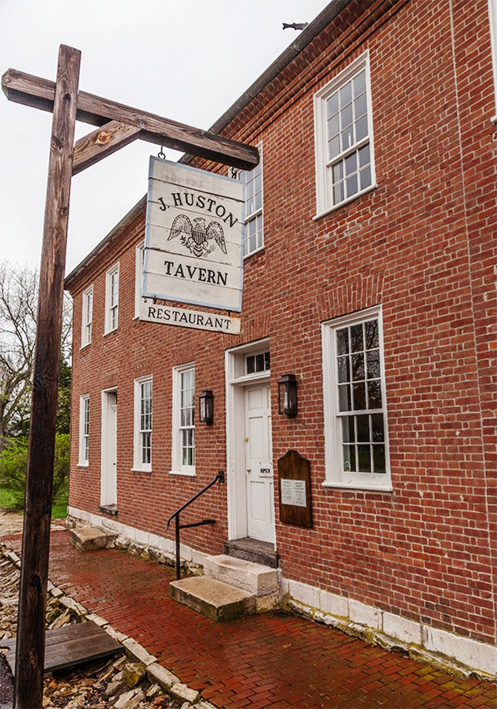 The tavern opened in 1834.
The tavern opened in 1834.
Among the village’s principal historic buildings are:
- The J. Huston Tavern, a Federal-style building that opened in 1834. A tour of the handsome brick building reveals its evolution from a simple four-room structure into the more elaborate tavern extant today;
- The home of artist George Caleb Bingham. This building is managed by the state and received its own designation as a National Historic Landmark in 1966. Other buildings operated by the state historic site include the old courthouse, the Academy Boarding House, the Dr. Mathew Hall House, and a stone jail
- The John P. Sites House, which dates from the 1830s, when it was built as a Federal-style cottage. John and his wife Nannie bought the house in 1866, and by the mid-1870s, they had remodeled the building giving it an upper story and an elaborate front porch. The Friends restored the home in 1970 and a second restoration in 1991 earned the organization the Albert B. Corey Award, the highest national award given a local historical organization by the American Association of State and Local History;
- The D. Lawless House is a tie to an Arrow Rock founder and represents a new era of farming in Saline County. In 2000 and 2001, the Friends of Arrow Rock received a substantial gift from one of its members for the restoration and maintenance of the Lawless House located at the edge of Arrow Rock. Owned by the State of Missouri, the friends signed a long-term lease on the property for the purpose of restoring the circa 1903 Queen Anne farmhouse. The property is currently used as an educational center for the Missouri River Bird Observatory; and
- The Brown Lodge of the Ancient Free and Accepted Masons was the first black lodge to be established in Arrow Rock. The Masons purchased the land on which the lodge was built on March 2, 1881. The Great Depression forced the closure of Brown Lodge. Remarkably, it still stands and is the only African-American lodge remaining of four that once stood in the community. Together these lodges provided social functions for their black members, but more importantly they provided a support. The lodges also sponsored women’s auxiliaries and juvenile groups. Brown Lodge was vacated in the 1950s and it suffered from neglect. Along with Brown’s Chapel, the lodge building was donated to the Friends of Arrow Rock in 1996. Its restoration was made possible through Missouri’s Neighborhood Assistance Program tax credits. The building is now open to the public and houses a museum with exhibits telling the story of Arrow Rock’s black history.
In addition to these major buildings, the village also features several antique and gift shops, bed and breakfast inns, restaurants, and the Arrow Rock Lyceum Theater, which presents professional repertory productions in the summer and fall.
The Friends of Arrow Rock has its offices in the 1904 Arrow Rock Stock Bank, which is the starting point for seasonal tours of the village. Along the block of storefront buildings known as ”the boardwalk,” you will find the town’s post office. Both buildings were rehabilitated in the early 1990s and preserve the appearance of each during the early 1900s while meeting modern needs of the preservation group.
The Friends of Arrow Rock benefit from the expertise of a highly qualified professional staff and consultants as well as the leadership of its volunteer board of trustees. Several special events held throughout the year showcase the history of the town. The mission of the organization is to share the rich and varied Missouri legacy with current and future generations. As stewards of its history, the friends safeguard the memories of the village by preserving its buildings and artifacts. Through exhibits and educational programs, the organization conveys the history of the area and its people to visitors.
Arrow Rock is a microcosm of the historic Missouri experience, including Native American inhabitation, European exploration, westward migration, and town growth, interlaced with commerce—and conflict. The organization aspires to help residents and visitors understand how communities change over time, adapting to adversity as well as prosperity. In doing this, the friends have embraced the whole truth about Arrow Rock’s past. By confronting, studying, and teaching about controversial issues such as the displacement of the Indians, enslavement of African Americans, the Civil War and its aftermath, as well as the decline, depopulation, and restoration of small rural towns, the Friends of Arrow Rock works to create a history-based community where encountering the past can help shape a better future.
Because its history is important and authentic, and its buildings are original and well-preserved in a scenic setting on the bluffs of the Missouri River, the organization seeks to cultivate and curate this site into one of the finest historic destinations in the country. As curators of historic buildings and artifacts, the Friends of Arrow Rock preserve and display its holdings in accordance with the best practices of historic preservation. In partnership with other groups who share a passion for the history of Arrow Rock, the friends also work for the development and promotion of local and regional cultural tourism. As stewards of a public trust, the friends are committed to providing the financial and administrative resources needed to ensure the future of Arrow Rock for generations to come.
For these reasons, the ISLPMC historic preservation awards committee is very proud to recognize the Friends of Arrow Rock tonight for its outstanding contributions to the recognition and preservation of Missouri’s Boone’s Lick Region’s heritage and material culture. To receive the ISLPMC Preservation Award tonight is Chair Toni Blackwood.
ISLPMC Historic Preservation Certificate of Merit
From the award presentation:
For ISLPMC’s Citation of Merit tonight we recognize the Old Munichburg Association, which has been integral to the preservation and interpretation of Jefferson City’s German-American neighborhood.
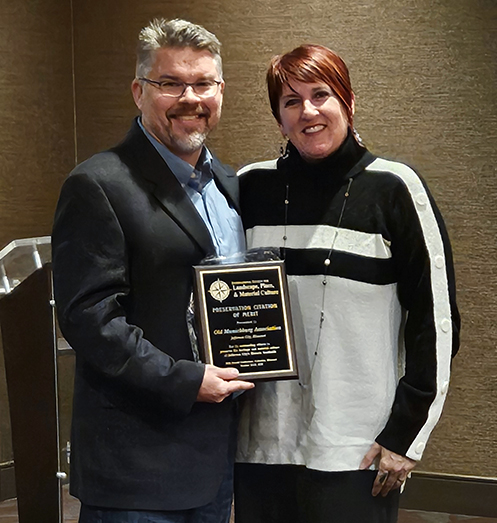
Munichburg offered newly arrived immigrants a place to assimilate American customs while maintaining their German identity. By the turn of the century, the neighborhood had become a self-supporting community with its own fire department, inns, schools, and churches, its own dry goods, furniture, clothing, hardware, grocery stores, and even its own brewery.
During the second half of the twentieth century, as older residents passed on, many of their descendants moved away, and sadly, the neighborhood began to deteriorate. The Old Munichburg Association was formed in 2000 and is dedicated to the revitalization of Jefferson City’s historic south side. The association includes current residents, business owners, and others who share a deep appreciation for the area and a desire to promote, preserve, and protect it.
Munichburg is the historic core of Jefferson City's south side. The neighborhood comprises approximately fourteen blocks located south of the Rex Whitton Expressway and east of US 54 West. The association also works with other south side groups. Today, residents are helping to preserve the area’s brick buildings, tree-lined streets, and a strong neighborhood identity. Munichburg remains very walk-able with dining and shopping just a few blocks away.
In 2002, the group was successful in getting a historic district centering on Broadway and Dunklin streets placed on the National Historic Register of Historic Places. The designation enabled property owners to take advantage of state and federal tax credits for rehabilitating historic buildings.
Almost since the organization’s founding, it has installed and maintained distinctive neighborhood banners identifying the historic district. In 2009, the association purchased and installed other decorative signs throughout the district. Association members also maintain plantings to help beautify the historic district.
In addition to promoting historic preservation, the association began several initiatives including:
- Securing public recognition of the neighborhood’s unique identity as the city’s historic “Germantown”;
- Protecting, rehabilitating, and improving its buildings and infrastructure;
- Improving connections among residents and with the city in general; and
- Celebrating the area’s history and heritage as an important part of the city’s German-American community.
Recent projects the association has undertaken include:
- The Dunklin Street murals, a series of panels commissioned by the association, and created by local artist Jim Dyke, to commemorate the rich history of Munichburg. The mural panels are located in the storefront windows at 117 East Dunklin;
- A gateway park at the northeast corner of Dunklin and Jefferson known as the “Munichburg Corner,” which memorializes the neighborhood’s past and its bright future. The project was completed in 2010 using salvaged building stones and was funded, in part, by selling commemorative bricks and pavers.
For 23 years, the association has held an Oktoberfest. A celebration of the Jefferson City Southside’s rich heritage, the annual event includes craft and food vendors, main stage entertainment, a beer and wine garden, a Dachshund Derby and costume contest, and the Mid-Missouri Old Car Club show. Jefferson City’s Oktoberfest is a fundraiser for the association, with proceeds going toward the revitalization of the neighborhood. Oktoberfest is always the last Saturday in September, and is held in the area centered around the Munichburg Corner. The entire city benefits from this festival, and many local businesses and nonprofit groups gain financially by their participation in Oktoberfest. Oktoberfest is the core fundraising event for the Old Munichburg Association.
Lastly, the association has an ongoing oral history program focusing on the longtime residents of Munichburg. In addition to interviewing, recording, and transcribing oral histories, the organization is also digitizing and archiving historic photos for its archives.
With all of this in mind, the ISLPMC historic preservation awards committee would very much like to recognize the Old Munichburg Association for its outstanding efforts to preserve the heritage and material culture of Jefferson City’s Historic Southside. To receive the ISLPMC Citation of Merit tonight is its Vice President, Laura Ward.
